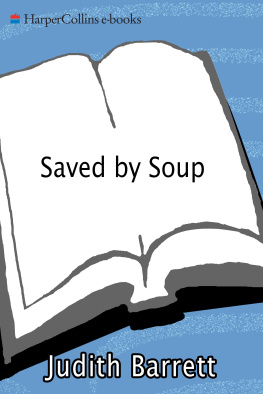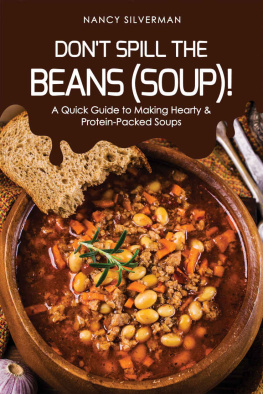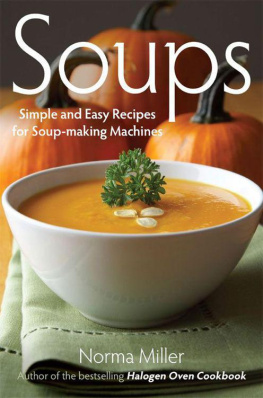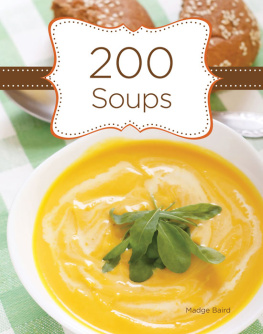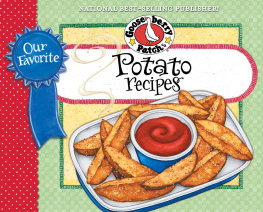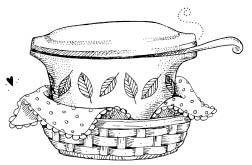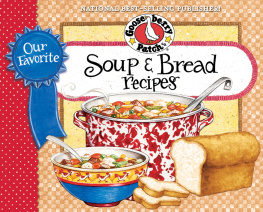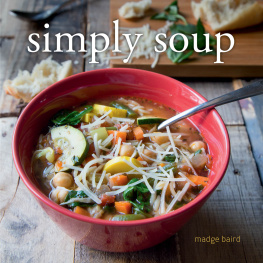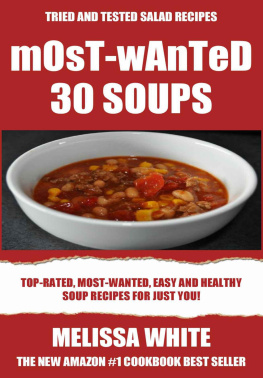O f all the foods we eat and enjoy, there is nothing like a bowl of soup to nourish, to comfort, and to satisfy. Nothing warms better on a cold winter day, or refreshes more on a hot summer night. And no prescription could ever heal quite like a bowl of chicken broth.
In addition to its popularity and flexibility, soup, it turns out, is ideal if youre counting calories and grams of fat. When I decided to shed excess pounds that were inching my scale up and my waistband out, I discovered how healthful and diet-friendly good soup can be when its part of a sensible eating plan.
Once I cut back on the quantities I was eating and the added fat in the food I was preparing, creating a satisfying dinner became a major challenge. It was then that I began eating low-fat soup regularly with lunch and dinner. As a gratifying, hunger-quelling, guilt-free first course, it provided balance and substance to a lean meal. I wasnt leaving the table hungry. Soupcomforting, warming, and fillingsaved the day, and me too.
Of course, not just any soup would do. It had to be low in fat and calories for me to be comfortable consuming it. I know too well the way commercial food purveyors cook to make food taste good: Take-out shops and restaurants pour in oil with abandon and add butter and cream copiously.
In my own kitchen I discovered that all types of soupsthick combinations of vegetables, beans, and grains, vegetable purees, or delicate, broth-based soupscan be created in a low-fat form without compromising either the taste or the texture. Thats because the combination of a savory broth and deliciously fresh raw ingredients results in hearty, satisfying, and well-flavored soups. So soup became one of the pillars of my diet, which was actually just a healthful approach to eating. Scientists, nutritionists, and doctors alike agree that a balanced diet low in fat along with a daily regimen of sensible exercise is the best way to live. And low-fat soups can be an ideal, integral part of that approach.
Some of the earliest soups, from ancient Rome, were like a porridge or thick gruel. Eventually it was discovered that broth could be poured over stale bread to make a hearty, nourishing, and cheap meal. The word soup actually comes from the Teutonic word for the slice of bread over which the broth was poured: sop and sup in old English, soupe (in French), sopa (in Spanish), and soep (in Dutch). Once broth was poured over bread it followed that broth could be poured over grains, legumes, meats, fish, game, and every noodle imaginable.
Now the whole world loves soup. The French have soupe and potage and the Italians zuppa (a thick soup) and brodo (broth). Asia has an abundance of soups, from the incredibly simple miso and dashi (broths) of Japan to the keng (a stew of meat and vegetables) of China, and the pho (noodle soups) of Vietnam. Russia, Ukraine, and Eastern Europe have borscht (always made with beet root, plus other ingredients) and shchi (always made with cabbage, plus other ingredients). There is gazpacho (made red with tomatoes or white with almonds) in Spain; scores of different dal shorba (lentil soups) in India; tinola (chicken soup) in the Philippines; harira (lamb soup) in Morocco; and pozole (hominy soup) in Mexico.
Drawing upon this vast gastronomic diversity and my foundation of culinary interests and work, I have tried to create a variety of recipes that are as delicious as they are healthful, and all very easy to prepare. Low-fat soups to eat and enjoy every day. You too can be Saved by Soup .
W ith so much hysteria these days about fat, it may be surprising to learn in this book of low-fat soups that there is some fat in almost every recipe.
These recipes are consistent with the current nutritional research and thinking with regard to fat and diet. Most nutrition experts recommend reducing fat in the average diet, but they also agree that fat shouldnt be cut out completely. In fact, they say that some fat in the average persons diet is actually beneficial. The specific amount of fat will vary from individual to individual, but it is generally accepted that about 30 percent of the calories in an average persons daily diet should come from fat. According to the Boston University Medical Center, the amount of fat in your daily diet depends on how many calories you take in. For example, a 1,600-calorie-a-day diet should contain approximately 53 grams of fat, while a 2,000-calorie-a-day diet should include 67 grams of fat.
Given that some fat is good for you, which fats are better and which ones should be avoided? In the most general terms, it is the saturated and transfats that should be avoided and the polyunsaturated and monounsaturated fats that should be preferred, although all types of fat and ultimately the total amount of fat in the diet should be controlled.
Animal fats are saturated fatsbutter, chicken fat, and lardand are generally not considered to be heart-healthy, while liquid vegetable fatscorn oil, safflower oil, sunflower oil, and soybean oil, which are polyunsaturated, and olive oil, canola oil, and peanut oil, which are monounsaturatedare lower in saturated fat and are viewed as easier on your heart. The exceptions are those few vegetable fats, such as palm kernel oil, and coconut oil, which are saturated and considered to be as unhealthful as animal fats. Saturated fats raise blood cholesterol levels more than anything else in the diet.
When it comes to losing weight, I often tell people, fat is fat; most fats are almost the same in terms of calories and total grams of fat. A tablespoon of butter has about 101 calories and a tablespoon of olive oil has about 119 calories. They both have about 12 grams of fat total. Butter, however, has 7 grams of saturated fat while olive oil has only 2 grams of saturated fat. When you switch to olive oil from butter you may be doing your heart a favor but both fats will have the same effect on your waistline.

